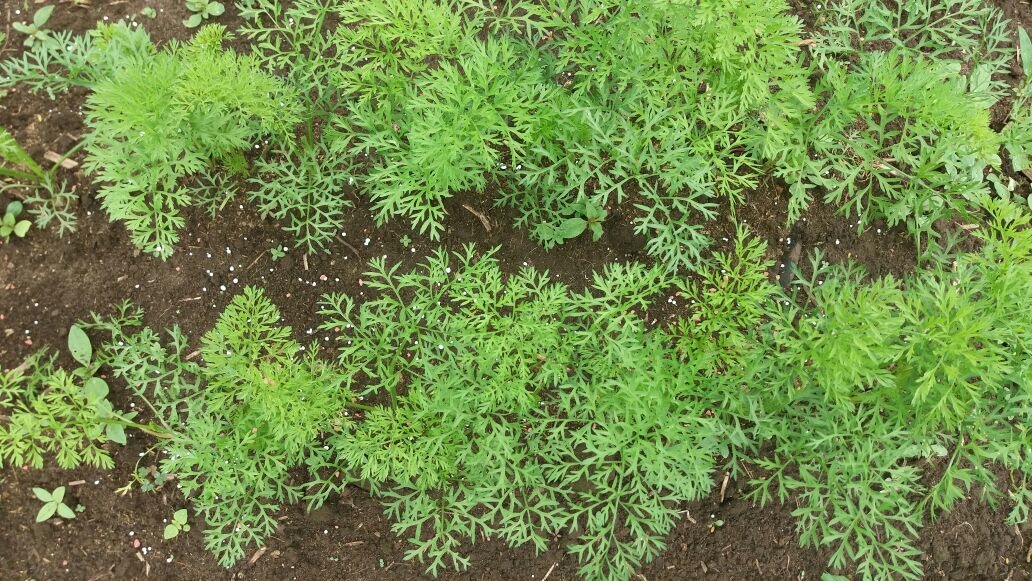Growth and yield of carrot inoculated with Bacillus subtilis and Pseudomonas fluorescens

Abstract
The objective of this study was to evaluate the effects of inoculation and co-inoculation with Bacillus subtilis and Pseudomonas fluorescens on carrots with reduced nitrogen use. A field experiment was carried on, with five treatments and five replicates, evaluating the growth and yield responses of inoculated carrots. Responses were observed in height only two weeks before harvesting, and the number of leaves was most affected from the beginning to the middle of the cultivation cycle. Although the fresh shoot mass was negatively affected by the inoculation treatments, the dry shoot mass did not respond to the rhizobacteria. The length of roots inoculated with P. fluorescens or co-inoculated with both bacteria increased from 21 cm, without inoculation, to 25 cm. The root volume and dry mass values were the same across the treatments. However, the fresh root mass was improved by between 70 and 81.8% with P. fluorescens and co-inoculation, respectively. More positive responses to inoculation were observed with reduced nitrogen levels, suggesting a potential in the rhizobacteria strains for use in reduced-input agricultural practices. Moreover, based on the findings, Pseudomonas fluorescens can be recommended as a plant growth-promoting microorganism in carrot cultivation.
Keywords
Daucus carota, Co-inoculation, Plant growth promoting rhizobacteria, Biofertilizers
References
Aloo, B.N., B.A. Makumba, and E.R. Mbega. 2019. The potential of Bacilli rhizobacteria for sustainable crop production and environmental sustainability. Microbiol. Res. 219, 26-39. Doi: 10.1016/j.micres.2018.10.011
CEAGESP, Companhia de Entrepostos e Armazéns Gerais de São Paulo. 2000. Normas de classificação da cenoura. CQH/CEAGESP, São Paulo, Brazil.
Chang, W.S., M. Van de Mortel, L. Nielsen, G.N. Guzman, X. Li, and L.J. Halverson. 2007. Alginate production by Pseudomonas putida creates a hydrated 133 microenvironment and contributes to biofilm architecture and stress tolerance under water-limiting conditions. J. Bacteriol. 189(22), 8290-8290. Doi: 10.1128/JB.00727-07
Clemente, J.M., C.R. Cardoso, B.S. Vieira, I.M. Flor, and R.L. Costa. 2016. Use of Bacillus spp. as growth promoter in carrot crop. Afr. J. Agric. Res. 11(35), 3355-3359. Doi: 10.5897/AJAR2016.11316
Corrêa, E.B., W. Bettiol, and J.C. Sutton. 2010. Controle biológico da podridão radicular (Pythium aphanidermatum) e promoção de crescimento por Pseudomonas chlororaphis 63-28 e Bacillus subtilis GB03 em alface hidropônica. Summa Phytopathol. 36(4), 275-281. Doi: 10.1590/S0100-54052010000400001
CQFS, Comissão de Química e Fertilidade do Solo. 2016. Manual de adubação e de calagem para os Estados do Rio Grande do Sul e de Santa Catarina. Sociedade Brasileira de Ciência do Solo, Porto Alegre, Brazil.
Fioreze, S.L., M.G. Pinheiro, Y.D. Pereira, and S.P. Cruz. 2020. Inoculation of wheat plants with Pseudomonas spp. and Azospirillum brasilense under drought stress. J. Exp. Agric 42(2), 1-7. Doi: 10.9734/jeai/2020/v42i230461
Fukami, J., C. de la Osa, F. Javier Ollero, M. Megías, and M. Hungria. 2018. Co-inoculation of maize with Azospirillum brasilense and Rhizobium tropici as a strategy to mitigate salinity stress. Funct. Plant Biol. 45, 328-339. Doi: 10.1071/FP17167
Hungria, M., M.A. Nogueira, and R.S. Araujo. 2013. Co-inoculation of soybeans and common beans with rhizobia and azospirilla: strategies to improve sustainability. Biol. Fertil. Soils 49(7), 791-801. Doi: 10.1007/s00374-012-0771-5
Kloepper, J.W., J. Leong, M. Teintze, and M.N. Schroth. 1980. Enhanced plant-growth by siderophores produced by plant growth-promoting rhizobacteria. Nature 286, 885-886. Doi: 10.1038/286885a0
Kozusny-Andreani, D.I., J.C. Agiado, and R. Andreani Junior. 2014. Efeito de bactérias rizosféricas sobre o desenvolvimento da cenoura. Rev. Univ. Vale Rio Verde 12, 211-220. Doi: 10.5892/ruvrd.v12i1.1368
Kumawat, K.C., P. Sharma, A. Sirari, I. Singh, B.S. Gill, U. Singh, and K. Saharan. 2019. Synergism of Pseudomonas aeruginosa (LSE-2) nodule endophyte with Bradyrhizobium sp. (LSBR-3) for improving plant growth, nutrient acquisition and soil health in soybean. World J. Microbiol. Biotechnol. 35, 47. Doi: 10.1007/s11274-019-2622-0
Lana, M.C., J. Dartora, D. Marini, and J.E. Hann. 2012. Inoculation with Azospirillum, associated with nitrogen fertilization in maize. Rev Ceres 59(3), 399-405. Doi: 10.1590/S0034-737X2012000300016
Lin, Y., D.B. Watts, J.W. Kloepper, Y. Feng, and H.A. Torbert. 2020. Influence of plant growth-promoting rhizobacteria on corn growth under drought stress. Commun Soil Sci. Plant Anal. 51(2), 250-264. Doi: 10.1080/00103624.2019.1705329
Matsuoka, H., Y. Ohwaki, J. Terakado-Tonooka, and F. Tanaka. 2016. Changes in volatiles in carrots inoculated with ACC deaminase-producing bacteria isolated from organic crops. Plant Soil 407, 173-186. Doi: 10.1007/s11104-015-2769-x
Mendes, I.C., M. Hungria, and M.A.T. Vargas. 2003. Soybean response to starter nitrogen and Bradyrhizobium inoculation on a cerrado oxisol under no-tillage and conventional tillage systems. R. Bras. Ci. Solo 27(1), 81-87. Doi: 10.1590/S0100-06832003000100009
Merriman, P.R., R.D. Price, J.F. Kollmorgen, T. Piggott, and E.H. Ridge. 1974. Effect of seed inoculation with Bacillus subtilis and Streptomyces griseus on the growth of cereals and carrots. Aust. J. Agric Res. 25(2), 219-226. Doi: 10.1071/AR9740219
Molla, A.H., Z.H. Shamsuddin, M.S. Halimi, M. Morziah, and A.B. Puteh. 2001. Potential for enhancement of root growth and nodulation of soybean coinoculated with Azospirillum and Bradyrhizobium in laboratory systems. Soil Biol. Biochem. 33(4), 457-463. Doi: 10.1016/S0038-0717(00)00186-3
Nick, C. and A. Borém. 2016. Cenoura do plantio à colheita. Editora UFV, Viçosa, Brazil.
Novoselov, V.S. 1960. A closed volumeter for plant root systems. Fiziologiya Rastenii 7, 243-244.
Patten, C.L. and B.R. Glick. 1996. Bacterial biosynthesis of indole-3-acetic acid. Can. J. Microbiol. 42(3), 207-220. Doi: 10.1139/m96-032
Paula, L.B. 2019. Cenoura: área menor, produtividade maior. Campo & Negócio, Piracicaba, Brazil.
R Core Team. 2020. R: A language and environment for statistical computing. R Foundation for Statistical Computing, Vienna.
Vessey, J.K. 2003. Plant growth promoting rhizobacteria as biofertilizers. Plant Soil 255(2), 571-586. Doi: 10.1023/A:1026037216893
Vieira, J.V. and H.B.S.V. Pessoa. 2008. Cenoura (Daucus carota): Clima. Embrapa Hortaliças, Brasilia, DF.
Zeffa, D.M., L.H. Fantin, A. Koltun, A.L.M. de Oliveira, M.P.B.A. Nunes, M.G. Canteri, and L.S.A. Goncalves. 2020. Effects of plant growth-promoting rhizobacteria on co-inoculation with Bradyrhizobium in soybean crop: a meta-analysis of studies from 1987 to 2018. Peer J. 8, e7905. Doi: 10.7717/peerj.7905
